Bearings, often the unsung heroes of the mechanical world, are fundamental Mechanical Components that have revolutionized machine construction and operation. These ingenious devices act as connectors or supports, allowing connected parts to rotate or move linearly relative to one another. Typically, one part remains fixed while the bearing supports the moving component, facilitating smooth and efficient motion in various mechanical systems.
The invention and development of bearings marked a pivotal moment in engineering, paving the way for advanced machinery and precise mechanical systems essential to modern technology. Bearings have transformed the field of mechanical engineering, enabling the creation of more efficient, durable, and high-performance machines. From the wheels of cars to power plant turbines, household appliances to industrial equipment, bearings play a crucial role in supporting and facilitating motion across diverse technologies.
The significance of bearings cannot be overstated. They reduce friction in mechanical systems, greatly improve energy efficiency, increase operational precision, and enhance overall system reliability. Bearings offer several key advantages in mechanical systems:
- They significantly reduce friction between moving parts, ensuring smoother operation.
- They support loads while allowing the desired motion, improving system stability.
- They minimize wear and tear, extending the lifespan of critical mechanical components.
- They reduce noise and vibration, enhancing machine performance.
Due to these benefits, bearings are indispensable, with applications in nearly every mechanical device and system across various industries. They are essential in fields such as automotive engineering, aerospace, industrial machinery, and consumer electronics. Bearings also enable advancements in high-speed transportation, renewable energy systems, and precision manufacturing, continually pushing the boundaries of mechanical capability.
Different Types of BearingsBottom of Form
The world of bearings is diverse, with various types designed to handle specific loads, and motions, or suit particular applications. Understanding these different types is crucial for engineers, designers, and mechanical enthusiasts. Here are the main categories of bearings:
- Rolling Element Bearings
- Plain Bearings (Sliding Bearings)
- Fluid Bearings
- Magnetic Bearings
- Flexure Bearings
Each of these bearing types has its own set of characteristics, advantages, and limitations, making them suitable for different applications across various industries. The choice of bearing type depends on factors such as load capacity, speed, precision requirements, environmental conditions, and cost considerations.
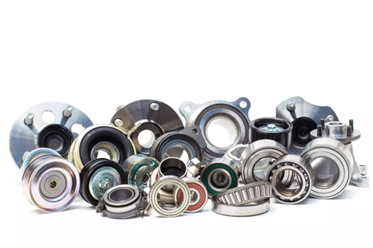
Types of Bearing Specifications in Table
| Bearing Type | Types | Key Features | Common Applications | Advantages | Disadvantages | Cost |
| Rolling Element Bearings | Ball Bearings, Roller Bearings, Thrust Bearings, Linear Bearings | Use rolling elements (balls or rollers) between races | Automotive, Industrial machinery, Aerospace, Home appliances | Low friction, High load capacity, High speed capability | Sensitive to contamination, Potential for fatigue failure | Moderate |
| Plain Bearings | Sleeve Bearings, Flange Bearings, Mounted Bearings, Thrust Bearings, Spherical Bearings | Sliding contact between surfaces | Automotive, Industrial machinery, Marine, Construction | Simple design, High load capacity, Cost-effective | Higher friction, Regular lubrication needed, Speed limitations | Low to Moderate |
| Fluid Bearings | Hydrostatic Bearings, Hydrodynamic Bearings | Use pressurized fluid film for support | Hard disk drives, High-speed machinery, Gas turbines, Aircraft control systems | Very low friction, High precision, Reduced vibration | Complex setup, Energy consumption, Potential for leakage | High |
| Magnetic Bearings | Active Magnetic Bearings, Passive Magnetic Bearings | Use magnetic fields for levitation | Power generation, Petroleum refinement, Turbomolecular pumps, Artificial hearts | No mechanical wear, High-speed operation, Precision control | High cost, Complex systems, Power dependency (for active) | Very High |
| Flexure Bearings | Single-part Flexures, Multi-material Flexures | Use material flexibility for motion | Door hinges, Precision instruments, Hostile environments | Simple design, No lubrication needed, Low friction | Limited range of motion, Material limitations | Low to Moderate |
What are Rolling Element Bearings?
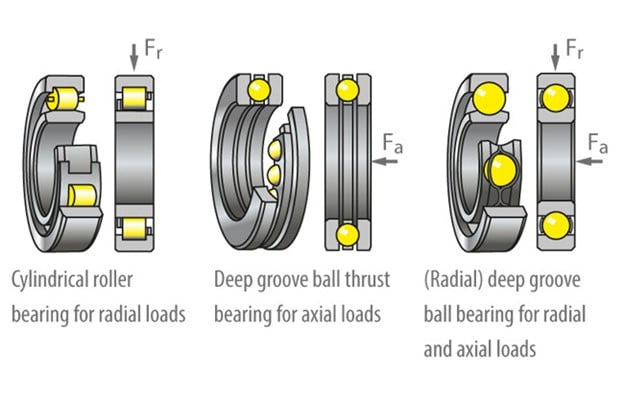
Rolling element bearings are mechanical components that use rolling elements such as balls or rollers to reduce friction between moving parts. They consist of an inner race, an outer race, rolling elements, and a cage or separator. These bearings are fundamental in modern machinery, enabling smooth rotation and linear motion in countless applications.
Working Principles of Rolling Element Bearings
Rolling element bearings operate on the principle of rolling friction, which is significantly lower than sliding friction. As the bearing rotates, the rolling elements move between the inner and outer races, distributing the load and allowing for smooth motion. The cage or separator keeps the rolling elements evenly spaced, preventing them from colliding with each other.
Applications of Rolling Element Bearings
Rolling element bearings are used in a wide range of applications, including:
- Automotive: Wheel bearings, transmission systems, and engine components
- Industrial machinery: Conveyors, pumps, and electric motors
- Aerospace: Aircraft engines, landing gear, and control systems
- Home appliances: Washing machines, refrigerators, and air conditioners
- Power generation: Wind turbines and generators
- Robotics: Joint mechanisms and actuators
Types of Rolling Element Bearings
There are several different types of rolling element bearings, including:
- Ball Bearings
- Deep Groove Ball Bearings: The most common type, versatile for both radial and thrust loads.
- Angular Contact Ball Bearings: Designed for combined radial and axial loads, often mounted in pairs.
- Self-Aligning Ball Bearings: Can accommodate misalignment between shaft and housing.
- Roller Bearings
- Cylindrical Roller Bearings: Excellent for heavy radial loads, and limited axial load capacity.
- Tapered Roller Bearings: Handle combined radial and axial loads, often used in wheel bearings.
- Spherical Roller Bearings: Can handle heavy loads and misalignment, used in industrial machinery.
- Needle Roller Bearings: Thin cylindrical rollers for high load capacity in compact spaces.
- Thrust Bearings
- Ball Thrust Bearings: For axial loads in low to medium-speed applications.
- Roller Thrust Bearings: Handle heavier axial loads than ball thrust bearings.
- Linear Bearings
- Ball Bushings: Allow linear motion along a shaft.
- Roller Slides: Use rollers for smoother linear motion and higher load capacity.
- Specialized Bearings
- Slewing Bearings: Large bearings that support slow rotation of heavy loads, often with integrated gears.
- Magnetic Bearings: Use magnetic fields to support loads without physical contact.
- Ceramic Bearings: Made from materials like silicon nitride for high-performance applications.
Advantages of Rolling Element Bearings
Rolling element bearings offer several advantages:
- Low friction and heat generation
- High load-carrying capacity
- Ability to operate at high speeds
- Long service life with proper maintenance
- Relatively compact design
- Standardized sizes for easy replacement
Disadvantages of Rolling Element Bearings
Some disadvantages of rolling element bearings include:
- Sensitivity to contamination and improper lubrication
- Potential for fatigue failure under heavy or cyclic loading
- Noise generation, especially at high speeds
- Higher initial cost compared to some plain bearings
- Limited ability to accommodate misalignment (except for self-aligning types)
What are Plain Bearings?
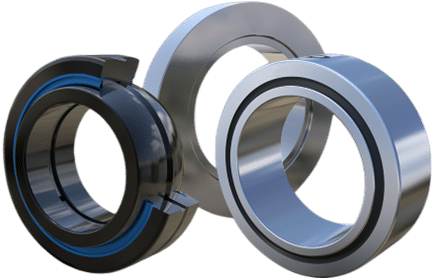
Plain bearings, also known as sleeve bearings or sliding contact bearings, are mechanical components designed to support a load and enable sliding or rotational motion between two surfaces. Unlike ball bearings or roller bearings, plain bearings do not use rolling elements but instead rely on a sliding interface. This simplicity in design makes them cost-effective and suitable for applications where durability and load-carrying capacity are paramount.
Plain bearings are essential components in mechanical systems where simplicity, reliability, and cost-effectiveness are critical factors. Their ability to support heavy loads and accommodate various types of motion makes them indispensable across industries ranging from automotive and aerospace to marine and construction. Understanding the different types, advantages, and limitations of plain bearings is crucial for selecting the most appropriate bearing for specific applications, ensuring reliable performance and extended service life.
Working Principles of Plain Bearings
Plain bearings operate on the principle of sliding friction between a shaft and the bearing surface. The bearing surface, often made from materials like bronze, polymers, or composites, is selected for its low friction characteristics. Lubrication is crucial to reduce friction and wear between the sliding surfaces, ensuring smooth operation and longevity of the bearing. This lubrication can be provided through oils, greases, or self-lubricating materials embedded within the bearing.
Applications of Plain Bearings
Plain bearings find extensive use across various industries due to their robustness and versatility:
- Automotive: Used in engine components such as crankshafts, connecting rods, and suspension systems.
- Industrial Machinery: Found in pumps, compressors, conveyors, and hydraulic systems.
- Aerospace: Critical for aircraft landing gear, engine mounts, and control systems.
- Marine: Support shafts, propeller systems, and steering mechanisms in ships and boats.
- Construction and Mining: Deployed in heavy machinery like excavators, bulldozers, and mining equipment.
Types of Plain Bearings
Plain bearings come in five main types, each tailored to specific application needs and performance criteria:
- Sleeve Bearings: Versatile and rugged, they support oscillating, rotating, or linear motion using materials like sintered bronze for durability and wear resistance.
- Flange Bearings: Mounted in a cast iron flange for stable radial and light axial load support, aiding in easier installation and alignment.
- Mounted Bearings: Precision-engineered for optimal fit, supporting high axial loads with features like flanges or pillow blocks for secure mounting.
- Thrust Bearings: Prevent lateral movement between rotary and stationary components, often self-lubricating and used in applications requiring thrust load support.
- Spherical Bearings: Facilitate rotary and angular motion with an inner race rotating angularly within an outer race, suitable for compensating shaft misalignment.
Each type offers distinct advantages in terms of load capacity, friction management, and ease of installation, catering to various industrial applications effectively.
Advantages of Plain Bearings
- Simplicity and Reliability: Plain bearings have a simple design with minimal moving parts, making them easy to install and maintain.
- High Load Capacity: Capable of handling heavy radial and moderate axial loads, making them suitable for demanding applications.
- Cost-Effectiveness: Generally less expensive to manufacture and maintain compared to roller bearings, making them economical for a wide range of applications.
- Versatility: Can accommodate various types of motion including sliding, rotating, oscillating, and reciprocating movements.
- Durability: When properly lubricated and maintained, plain bearings can operate reliably in harsh conditions, offering long service life.
Disadvantages of Plain Bearings
- Higher Friction: Plain bearings exhibit higher friction compared to roller bearings, which can lead to increased energy consumption and heat generation.
- Lubrication Requirements: Regular lubrication is essential to prevent wear and ensure smooth operation. Improper lubrication can lead to premature failure.
- Speed Limitations: Not suitable for high-speed applications due to frictional heat build-up and potential for wear.
- Maintenance: May require more frequent inspection and maintenance compared to some rolling element bearings to ensure optimal performance and longevity.
What are Fluid Bearings?
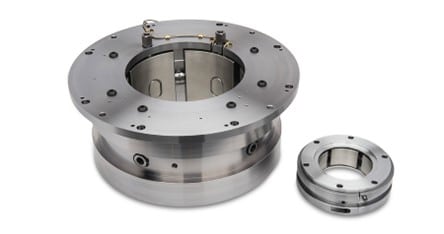
Fluid bearings are specialized types of bearings where the load is supported by a thin layer of rapidly moving pressurized liquid or gas between the bearing surfaces. This thin fluid layer replaces the metallic contact in traditional bearings, significantly reducing friction, wear, and vibration. Due to the absence of direct contact between moving parts, fluid bearings can achieve near-zero wear when operated correctly. This makes them ideal for high-speed, high-load, and high-precision applications.
Working Principles of Fluid Bearings
Fluid bearings function based on the principle of separating the bearing surfaces with a pressurized fluid, which can either be a liquid or a gas. This pressurized fluid forms a thin film that supports the load and enables smooth relative motion between the bearing surfaces. The two main types of fluid bearings are:
- Hydrostatic Bearings: These bearings utilize an external pump to pressurize the fluid. The fluid, typically oil, water, or air, is injected into the bearing gap through dedicated holes or channels. This external pressure is essential to maintain the fluid film and support the load, even when the bearing is stationary.
- Hydrodynamic Bearings: In these bearings, the fluid pressure is generated by the relative motion between the bearing surfaces. As the journal (the part of the shaft that interacts with the bearing) moves, it drags the fluid into a wedge-shaped gap, creating a dynamic pressure that supports the load. This type of bearing relies on the motion to maintain the fluid film, making it effective at higher speeds.
Applications of Fluid Bearings
Fluid bearings are versatile and find use in various demanding applications where traditional bearings would fall short. Some typical applications include:
- Hard Disk Drive Motors: Fluid bearings provide quieter operation and longer life compared to ball bearings.
- High-Speed Machinery: They are used in applications requiring high precision and reliability, such as CNC machines and high-speed spindles.
- Gas Turbines and Pumps: Fluid bearings handle high loads and reduce wear in these high-speed, high-temperature environments.
- Aircraft Control Systems: Their precision and reliability are crucial for maintaining control surfaces.
Types of Fluid Bearings
- Hydrostatic Bearings: Hydrostatic bearings are designed to handle large loads and offer excellent damping properties with minimal wear. They provide precise control over positioning and motion. These bearings are particularly suited for applications requiring high precision, such as machining spindles, gas turbines, and aircraft control systems.
- Hydrodynamic Bearings: Hydrodynamic bearings are characterized by their simpler design and ability to function without external lubrication systems. They are effective in applications that involve moderate to high speeds and offer high damping energy absorption and vibration reduction. Common uses include pumps, turbines, marine systems, and various industrial equipment.
Advantages of Fluid Bearings
- Low Friction and Wear: The absence of direct contact between the bearing surfaces reduces friction and wear, leading to a longer lifespan.
- High Precision: Hydrostatic bearings provide precise control over positioning and movement, essential for applications requiring high accuracy.
- Reduced Vibration: Fluid layers dampen vibrations, resulting in smoother and quieter operation.
- Long Lifespan: With proper maintenance and operation, fluid bearings can last significantly longer than traditional bearings.
- Quiet Operation: Fluid bearings operate more quietly than rolling-element bearings, making them suitable for noise-sensitive environments.
Disadvantages of Fluid Bearings
- Complex Setup: Hydrostatic bearings require external pumps and complex control systems to maintain the fluid pressure, leading to higher initial costs and complexity.
- Energy Consumption: Maintaining the necessary fluid pressure consumes energy, making hydrostatic systems less efficient.
- Temperature Sensitivity: Fluid properties change with temperature, which can affect the performance of the bearing.
- Potential for Leakage: Keeping the fluid contained within the bearing can be challenging, especially in high-speed or high-pressure applications.
- Risk of Seizure: Hydrostatic bearings can seize if fluid pressure is lost, whereas mechanical bearings degrade more gradually.
- Maintenance Requirements: Ensuring the proper function of the external pump and fluid containment systems requires regular maintenance.
What are Magnetic Bearings?
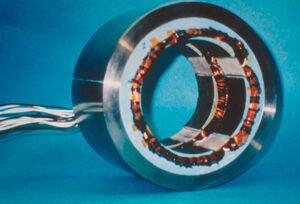
Magnetic bearings are specialized types of bearings that support a load using magnetic levitation. These bearings support moving parts without physical contact, allowing them to levitate a rotating shaft and permit relative motion with very low friction and no mechanical wear. Due to the absence of direct contact between moving parts, magnetic bearings can achieve the highest speeds of any kind of bearing and have no maximum relative speed. This makes them ideal for high-speed, high-precision applications where traditional bearings would be unsuitable.
Working Principles of Magnetic Bearings
Magnetic bearings function based on the principle of electromagnetic suspension. They use magnetic fields to levitate and control the position of a rotor or other moving parts. The two main types of magnetic bearings are:
- Active Magnetic Bearings: These bearings utilize electromagnets controlled by a feedback system. Sensors detect the position of the rotor, and a control system adjusts the electromagnetic force to maintain the desired position. This active control allows for precise positioning and stability.
- Passive Magnetic Bearings: In these bearings, permanent magnets are arranged to create a stable magnetic field without the need for power input or control systems. The magnetic forces naturally keep the rotor in position, though they are more challenging to design due to limitations described by Earnshaw’s theorem.
Applications of Magnetic Bearings
Magnetic bearings are versatile and find use in various demanding applications where traditional bearings would fall short. Some typical applications include:
- Electrical power generation
- Petroleum refinement
- Machine tool operation
- Natural gas handling
- Uranium enrichment (in Zippe-type centrifuges)
- Turbomolecular pumps
- Watt-hour meters in electric utilities
- Energy storage systems (e.g., flywheels)
- Maglev trains
- Artificial hearts and ventricular assist devices
Types of Magnetic Bearings
- Active Magnetic Bearings: Active bearings offer several advantages, including the ability to accommodate irregularities in mass distribution automatically, allowing rotors to spin around their center of mass with very low vibration. They require continuous power input and an active control system to keep the load stable.
- Passive Magnetic Bearings: Passive bearings use permanent magnets and do not require any input power. However, they are difficult to design due to the limitations described by Earnshaw’s theorem. Techniques using diamagnetic materials are relatively undeveloped and strongly depend on material characteristics.
Advantages of Magnetic Bearings:
- Low Friction and Wear: The absence of physical contact between moving parts virtually eliminates friction and mechanical wear, leading to a longer lifespan and reduced maintenance needs.
- High-Speed Operation: Magnetic bearings can support the highest speeds of any bearing type, making them ideal for high-speed machinery and turbines.
- Precision Control: Active magnetic bearings offer precise positional control and can automatically adjust to accommodate irregularities in mass distribution, resulting in very low vibration.
- Vacuum Compatibility: With no need for lubrication, magnetic bearings can operate effectively in vacuum environments, crucial for certain scientific and industrial applications.
- Environmental Friendliness: The lack of lubricants makes magnetic bearings a cleaner option, reducing the risk of contamination in sensitive processes.
Disadvantages of Magnetic Bearings:
- Cost and Complexity: Magnetic bearings, especially active ones, require sophisticated control systems and power electronics, leading to higher initial costs and system complexity.
- Size and Weight: The electromagnets and associated control systems often result in bearings that are larger and heavier than conventional alternatives.
- Power Dependency: Active magnetic bearings require a continuous power supply to operate, which can be a limitation in some applications and may necessitate backup systems.
- Limited Load Capacity: Compared to some conventional bearings, magnetic bearings may have lower load-bearing capacities, particularly in passive designs.
- Thermal Sensitivity: The performance of magnetic bearings can be affected by temperature changes, which may impact their stability and efficiency in certain environments.
- Backup Requirements: In case of power failure or control system malfunction, magnetic bearings typically need backup mechanical bearings, adding to the overall system complexity.
What are Flexure Bearings?
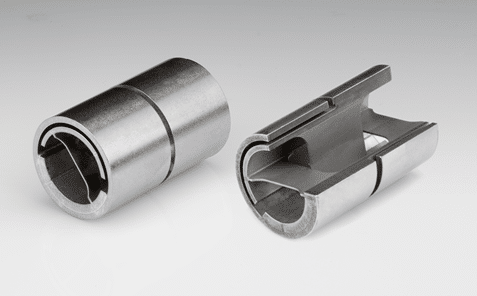
Flexure bearings are specialized types of bearings engineered to be compliant in one or more angular degrees of freedom. They are often part of compliant mechanisms and serve much the same function as conventional bearings or hinges in applications requiring angular compliance. Flexure bearings operate by bending a load element, allowing motion between two parts without the need for lubrication and with very low or no friction. This makes them ideal for applications requiring simple, compact, and low-friction movement solutions.
Working Principles of Flexure Bearings
Flexure bearings function based on the principle of material flexibility. They typically consist of two rigid structures joined by a thin “hinge” area that bends to allow movement. The key aspects of their operation include:
- Material Flexibility: The bearing element is made of a material that can be repeatedly flexed without disintegrating.
- Bending Motion: Instead of sliding or rolling, flexure bearings achieve motion through the bending of materials at a microscopic level.
- Angular Compliance: They are designed to allow movement in one or more specific angular directions while restricting movement in others.
Applications of Flexure Bearings
Flexure bearings are used in various applications where simple, low-friction movement is required. Some typical applications include:
- Door hinges
- Lids for Pez dispensers
- Flip-top covers
- Precision measuring equipment
- Rag joints in some sports car drive shafts
- Environments hostile to lubricants (underwater, in a vacuum, at elevated temperatures)
Types of Flexure Bearings
While the provided information doesn’t specify distinct types of flexure bearings, they can be categorized based on their design and application:
- Single-part Flexures: Many flexure bearings are made of a single part, with two rigid structures joined by a thin “hinge” area.
- Multi-material Flexures: Some flexures, like rag joints in car drive shafts, use rubberized fabric to achieve the desired flexibility and load-bearing capacity.
Advantages of Flexure Bearings:
- Simplicity and Low Cost: Flexure bearings are often simpler and less expensive to manufacture than other bearing types.
- Compact and Lightweight: Their simple design allows for compact and lightweight implementations.
- Very Low Friction: They exhibit very low or no friction, making them ideal for precision applications.
- No Lubrication Required: Flexure bearings don’t need lubrication, allowing use in hostile environments.
- Predictable Friction: The bending motion provides very uniform and predictable friction.
- Quiet Operation: They don’t produce noise during operation.
- Long Lifespan: In non-corrosive environments, flexure bearings can have an unlimited lifespan.
Disadvantages of Flexure Bearings:
- Limited Range of Motion: Flexure bearings typically have a limited angular excursion, especially for high-load applications.
- Material Limitations: They require materials that can withstand repeated flexing without fatigue or failure.
- Installation Challenges: Flexure bearings can be more difficult to install compared to some other bearing types.
- Cost in Some Applications: While generally inexpensive, they can be more costly than ball bearings in certain scenarios.
- Design Considerations: Careful consideration of material properties is necessary to avoid fatigue with normal use.
Conclusion
Bearings are fundamental components in mechanical systems, playing a crucial role in enabling smooth motion and reducing friction across a wide range of applications. From the versatile rolling element bearings to the high-precision magnetic bearings, each type offers unique advantages and limitations. The choice of bearing depends on specific application requirements, including load capacity, speed, precision, environmental conditions, and cost considerations. As technology advances, bearings continue to evolve, pushing the boundaries of mechanical engineering and enabling the development of more efficient, durable, and high-performance machines across various industries. Understanding the characteristics and applications of different bearing types is essential for engineers and designers to make informed decisions in creating optimal mechanical systems.
FAQs about Types of Bearings
- What are the main categories of bearings?
The main categories of bearings are Rolling Element Bearings, Plain Bearings (Sliding Bearings), Fluid Bearings, Magnetic Bearings, and Flexure Bearings. - How do magnetic bearings differ from traditional bearings? A: Magnetic bearings support loads using magnetic levitation, allowing for contact-free operation with very low friction and no mechanical wear. They can achieve the highest speeds of any bearing type and are ideal for high-precision applications.
- What are the advantages of fluid bearings?
Fluid bearings offer low friction and wear, high precision, reduced vibration, long lifespan, and quiet operation. They are particularly suitable for high-speed, high-load, and high-precision applications. - In what applications are flexure bearings commonly used? Flexure bearings are commonly used in applications such as door hinges, lids for Pez dispensers, flip-top covers, precision measuring equipment, and environments hostile to lubricants (underwater, in a vacuum, at elevated temperatures).
- What are the main disadvantages of magnetic bearings? The main disadvantages of magnetic bearings include high cost and complexity, larger size and weight compared to conventional bearings, power dependency for active systems, limited load capacity in some designs, thermal sensitivity, and the need for backup bearings in case of power failure.
